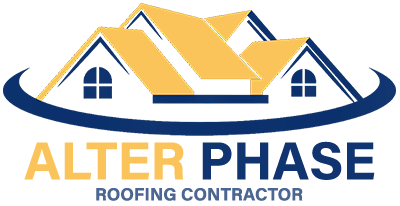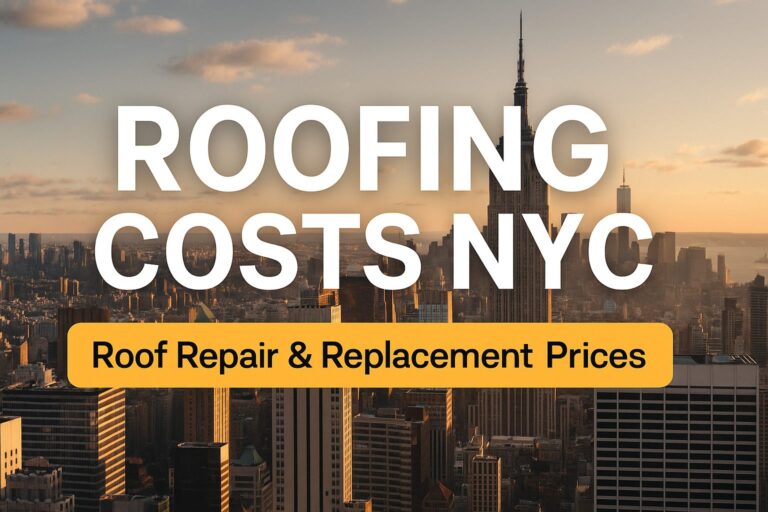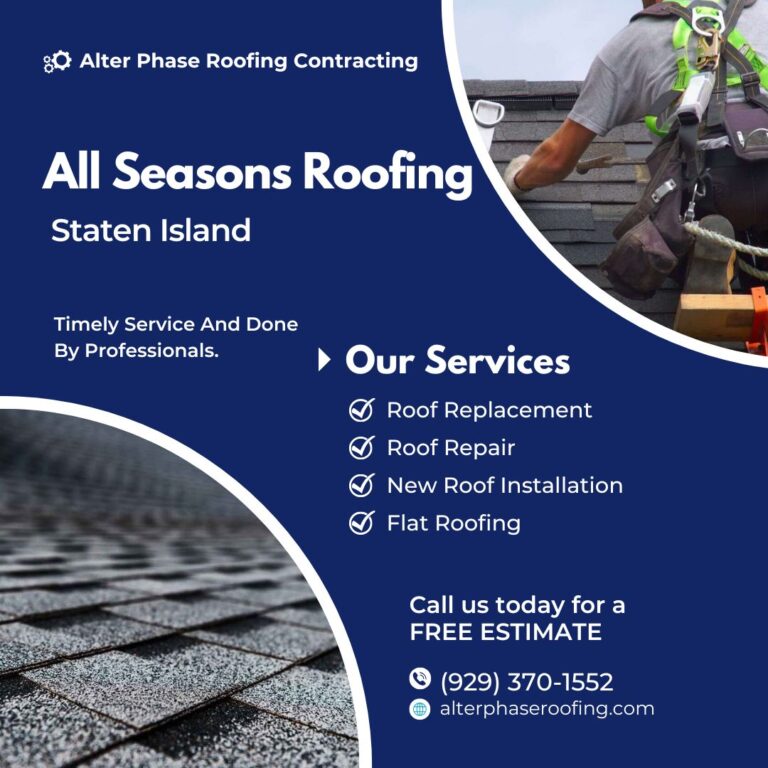Your roof is one of your home’s most crucial defenses against the elements, but it’s also a major investment. The average roof replacement in Staten Island can cost anywhere from $5,000 to $18,000, or more depending on factors like size and material.
Choosing the right roofing material is essential for maximizing the lifespan of your roof, boosting energy efficiency, and enhancing the overall look of your home.
This detailed guide will give you the knowledge you need to make an informed decision and protect your property for decades to come.
Understanding Your Needs: A Guide for Staten Island and Brooklyn Homeowners
Before explaining the roofing materials, it’s important to assess your specific requirements as a homeowner in Staten Island or Brooklyn. Here are the key areas to consider:
Coastal Climate
Staten Island and Brooklyn’s proximity to the coast brings unique weather challenges. Your roofing material needs to withstand strong winds, heavy downpours, potential salt spray, and fluctuations in temperature.
Wind Resistance: Look for materials with high wind ratings to avoid damage during those nor’easters.
Waterproofing: Prioritize materials known for shedding water effectively to minimize the risk of leaks.
Durability: Choose materials resistant to the harsh coastal environment.
Your Roof’s Pitch: The angle or slope of your roof dictates which roofing materials are suitable and also influences drainage efficiency.
Steeper Slopes: Often seen in the historic districts of Brooklyn and Staten Island, these are better suited for materials that shed water quickly, like metal roofing or traditional shingles.
Lower Slopes: More common in certain neighborhoods, these roofs might need specialized materials with enhanced waterproofing capabilities.
Working with Your Budget: Roofing projects can range in cost depending on the material, size of your roof, and labor. It’s essential to have a realistic budget in mind:
Lifespan: Consider the lifespan of the materials you are interested in to determine long-term cost-effectiveness.
Installation: Be aware of the potential differences in installation costs between different roofing materials.
Maintenance: Factor in any ongoing maintenance needs specific to certain types of roofing materials.
Aesthetics: The roofing material you choose will significantly impact the overall look of your home. Consider the architectural style of your house and the neighborhood as a whole.
Historic Charm: If you live in a brownstone-lined block in Brooklyn or a historic Victorian neighborhood on Staten Island, selecting materials that complement that aesthetic is key.
Modern Updates: Many areas in both boroughs feature more contemporary homes where sleek metal roofs or unique materials can elevate the style.
Remember, finding the right roofing material is about balancing these factors – weather resistance, roof pitch, budget, and aesthetics – to ensure a solution that is as beautiful as it is functional for your Brooklyn or Staten Island home.
Exploring Roofing Material Options
Now that you understand the factors influencing your decision, let’s get into the most common roofing materials and their unique strengths and considerations:
Asphalt Shingles
Advantages:
Affordability: Asphalt shingles are one of the most budget-friendly roofing options.
Versatility: Available in a vast array of colors and styles to complement various home styles.
Ease of Installation: Relatively straightforward for experienced contractors, potentially lowering labor costs.
Disadvantages:
Shorter Lifespan: Compared to metal or tile, asphalt shingles typically need replacing sooner (15-30 years depending on quality).
Vulnerability: More susceptible to wind damage, algae growth, and fading in harsh weather.
Metal Roofing
Advantages:
Extreme Durability: Can withstand heavy rain, snow, hail, and strong winds.
Longevity: Often boasts lifespans of 50+ years.
Energy Efficiency: Reflects sunlight, keeping your home cooler and potentially reducing energy bills.
Environmentally-Friendly: Often made with recycled content and recyclable at the end of its lifespan.
Disadvantages:
Higher Upfront Cost: The initial investment is greater than asphalt shingles.
Noise Potential: Can be noisier during heavy rain or hail if proper insulation is not used.
Tile Roofing
Advantages:
Exceptional Longevity: Clay and concrete tiles often last upwards of 50 years, some even over a century.
Distinctive Style: Adds a touch of Mediterranean or Spanish-inspired elegance.
Fire Resistance: Excellent for areas with wildfire risk.
Disadvantages:
Significant Weight: Your roof structure may need reinforcement to support tile’s weight.
High Cost: One of the most expensive options, both for materials and specialized installation.
Fragility: Individual tiles can crack under impact (from falling branches, etc.).
Wood Shakes
Advantages:
Natural Beauty: Offers a unique, organic aesthetic.
Insulation: Provides good insulation value.
Disadvantages:
Fire Risk: More susceptible to fire than other materials.
High Maintenance: Requires regular treatments to prevent rot and insect infestation.
Shorter Lifespan: Typically lasts less than other materials if not meticulously maintained.
Beyond the Basics
- Green Roofs: An eco-friendly option involving plants and soil, ideal for flat roofs in urban areas.
- Rubber Roofing: Known for waterproofing capabilities, often used on low-sloped roofs.
- Synthetic Slate: Mimics the look of natural slate at a lower cost and weight.
Important Note: The suitability of specific materials can vary based on your roof’s pitch, local building codes in Staten Island or Brooklyn, and your individual preferences.
Additional Considerations
Choosing a roofing material is just one piece of the puzzle. Here are other essential factors to think about:
- Local Building Codes and Regulations: Before making your final decision, it’s crucial to familiarize yourself with any building codes or restrictions specific to your area. These codes may influence the types of materials allowed or require certain roofing standards.
- Staten Island Resources: https://www.nyc.gov/site/buildings/codes/codes.page
- Brooklyn Resources: https://www.nyc.gov/site/buildings/codes/codes.page
- Professional Installation: The Importance of Expertise: Even the best roofing material won’t perform as intended if not installed correctly. Always choose licensed and insured roofing contractors with a proven track record. They understand the nuances of different materials and ensure your roof functions properly.
- Alter Phase Roofing: Call us (929) 370-1552 to get a free estimate for your roofing project.
- Warranties and Guarantees: Understanding Your Coverage: Most roofing materials come with warranties, but the coverage varies. Carefully review the terms offered by different manufacturers and contractors:
- Material Warranty: Covers defects in the materials themselves.
- Workmanship Warranty: Covers issues related to installation errors.
Note: Always inquire about warranties before committing to a specific product or contractor.
A new roof is a significant undertaking, but selecting the right material ensures a return on your investment for decades. Remember, durability and weather resistance should be top priorities for coastal homeowners in Staten Island and Brooklyn. Don’t be afraid to invest in premium materials that withstand the elements and add timeless beauty to your property. With a thoughtfully chosen roof, you’ll enjoy the peace of mind that comes with protecting one of your most valuable assets.
Appendix: Glossary of Roofing Terms
- Decking/Sheathing: The structural base, usually plywood or oriented strand board (OSB), that roofing materials are attached to.
- Drip Edge: Metal flashing installed along the roof’s edges to direct water away from the fascia and into your gutters.
- Eaves: The lower edges of your roof that extend out past the exterior walls of the building.
- Fascia: The vertical board that runs along the roof line and often holds the gutters.
- Flashing: Metal or other materials used to seal joints and gaps around roof penetrations like chimneys, vent pipes, and skylights, preventing leaks.
- Gable Roof: A classic roof style with two sloping surfaces that meet to form a triangular peak (the gable).
- Hip Roof: A roof with slopes on all four sides, creating a more pyramid-like shape.
- Pitch: The steepness of your roof, expressed as a ratio of vertical rise over horizontal run (e.g., a 6:12 pitch means the roof rises 6 inches for every 12 inches horizontally).
- Rafters: The angled structural beams that create the framework of your roof.
- Shingle: Individual overlapping roofing elements that comprise the main covering of a roof.
- Square: A unit of roofing measurement – one square covers 100 square feet of roof area.
- Underlayment: A water-resistant layer installed beneath the shingles for added protection against moisture.
- Valley: The inward angle formed where two sloping roof sections meet.pen_spark




